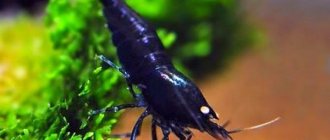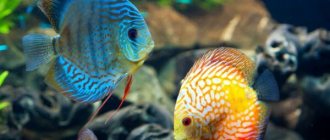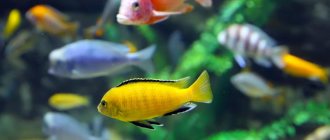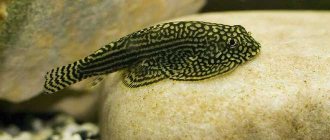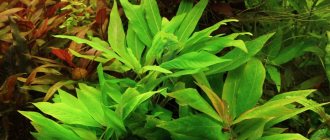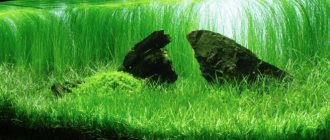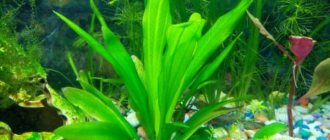In the wild, macrobrachium shrimp live in streams and freshwater reservoirs in Asia and America. The genus Macrobrachium has more than two hundred species, the name of each of which is associated with the color of the shell or the area. The color of shrimp is quite diverse, both in natural conditions and when bred in an aquarium. The color is influenced by the soil in which they live constantly. Some species are aggressive, while others, on the contrary, are quite peaceful. As a result of the construction of dams and other barriers, the number of macrobrachium shrimp is significantly reduced. Reproduction becomes impossible due to obstacles that prevent the larvae from migrating to salt water and then back to fresh water.
Macrobrachium species
The following species are most suitable for breeding at home:
- red-rusty;
- Japanese;
- Indian glass;
- ring-armed.
Many species are practically indistinguishable from each other, and some do not have a name at all. They differ from each other in a variety of color options. As they mature, their coloration changes depending on the shade of the soil. A distinctive feature of all shrimps of this genus is a huge second pair of limbs, which is especially noticeable in males. However, in some species one claw is of normal size, and the other is elongated.
Content
- 1 Description
- 2 Contents
- 3 Behavior
- 4 Reproduction
- Other names: Macrobrachium nipponense, Oriental river shrimp, Oriental river shrimp.
- Size: 7-8 cm.
- Temperature: 26-30 °C.
- Water parameters: pH 6.5-6.8.
- Behavior: not aggressive, does not get along well with small sedentary fish, eats snails and long-leaved soft plants.
- Difficulty of maintenance: easy, but requires oxygen enrichment and water circulation.
Description
Adult macrobrachium shrimp (photo below) reach twenty centimeters in length. Females are only 2 cm longer than males. The color range is as follows: yellow, black, blue. The claws are orange or red-brown in color.
The larvae develop in brackish water. They feed on algae and snails. Shrimp quite actively defend their interests in the struggle for a certain territory. If there are several males in the aquarium, then after a short period one dominant one will appear, which will have intact claws. For others, they will be absent - this is the result of the battle. In order to avoid such wars, it is necessary to provide each individual with approximately twenty liters of water. And besides, it is better to keep more females in the aquarium; a ratio of 1:3 will be the most optimal. Ideal neighbors are:
- Ancistrus;
- apistograms.
Macrobrachium shrimp prefer a nocturnal lifestyle. Sexual maturity is reached at six months. In some individuals, one claw is noticeably longer than the second. In males, a pair of second limbs may exceed the size of the body. Shrimp are very clean and regularly clean their claws of dirt. The limbs have sensory functions. They smell food thanks to the presence of chemoreceptors, which are located on six legs. During courtship, the male hugs the female with his claws and holds her tightly in his arms.
Macrobrachium is a genus of shrimp with long claws
Macrobrachium (Macrobrachium) is a genus of shrimp, classified in the Palaemonidae family, which has more than 200 species. A distinctive feature of Palemonids is an enlarged second pair of limbs, which is why they are called: long-clawed or large-armed (long-armed). They live in seas, oceans, freshwater bodies of water, rivers, and mountain streams. There are even unique, blind species that inhabit underwater caves. Palemonids - Macrobrachiums live where there is clean running fresh water - in river mouths, mountain streams.
Conditions of detention
- Latin name: Macrobrachium sp.
- Family: Palaemonidae
- Russian name: Macrobrachium
- Habitat: different areas of the planet
- Level of care: depending on type
- Regular sizes: up to 8 cm
- Chem. parameters: pH 6.0-8.0
- Water temperature: 22-28°C
It is not difficult to organize the maintenance of these shrimps in a common aquarium; you just need to carefully select the size of Macrobrachium specimens suitable for your volume. There are many species of Macrobrachium shrimp with different sizes, from the small 3.5 cm ( kulsiense ) to the giant 45 cm ( rosenbergii ). Large shrimp are kept and bred on farms, and then sold as a gourmet product.
Appearance
Most long-clawed shrimp are predators , but some of them are peaceful creatures. They are usually small in size - transparent banjare (3 cm) or completely transparent Indian glass ehemals (4-6 cm). For aquarists, the most interesting are medium-sized aquarium shrimp, such as nipponense (7-8 cm). These shrimp can be placed in an aquarium if you create conditions for them that are close to natural.
Habitat
The habitat of Macrobrachium is unusually wide - Australia, America, Malaysia, Thailand, Nepal, India, Pakistan and many other regions. They also live at the mouths of Sakhalin rivers. The natural conditions in the regions are varied - tropics and subtropics with temperatures up to 32°C. Macrobrachium shrimp - assamense ( 7 cm ), inhabiting mountain streams in the eastern Himalayas, calmly tolerate temperatures dropping to 20°C.
At home, keeping Macrobrachium shrimp in an aquarium is possible with a constant supply of oxygen and active filtration of water. Equipment - aerators and filters - must operate around the clock.
Water parameters
Shrimp will not have any special requirements for water quality. For each subspecies they can vary over a wide range. It is better if the pH parameters do not go beyond 6.7-8.5. In an aquarium where large specimens live, the pH level should not be lower than 7.0 - under this condition, molting occurs faster and the shrimp safely shed their old shell. Most subspecies of large-armed arthropods live in bodies of water with tropical and subtropical climates, so these are the ones most often sold in pet stores. For them, the temperature in the home aquarium must be maintained within 22-28°C.
Shrimp aquarium
Small and peaceful shrimps will happily fit into an aquarium with a volume of 80 liters or more, and will not be unpleasant neighbors for fish and algae. For individuals with a size of 7 cm and larger, an aquarium of 120 liters will be required. All large Macrobrachiums have a dominant and predatory character. A group of several females (from 4-5 pieces) and a male leader requires a large territory in the aquarium. Calculation of water volume: from 13-18 liters per shrimp.
It will be very difficult to create conditions for shrimp from 8-12 cm in size in a 100 liter aquarium, even for an aquarist with extensive experience. Watching constant fights between shrimp for the best territory in the aquarium, especially during the breeding season, may seem interesting, but it will soon end in the death of most individuals. You can reduce the level of aggression of predators if you place a lot of shelters in the aquarium - driftwood, algae, shells or artificial structures.
Keeping with other types of shrimp
It is not worth keeping shrimp of the genus Macrobrachium in an aquarium together with representatives of other species of the Palemonidae family - they must have different conditions of detention, including feeding. Destroying weaker competitors for a place in the aquarium is in the order of things for them. Aquarists allow different species of Macrobrachium to be kept in one aquarium, but only if they are the same size and there is enough food and territory for them at the bottom of the aquarium. All representatives of this genus are bottom-dwelling animals and, if there is a shortage of food, they will quickly eat smaller individuals .
If you plant a lot of algae in the soil of the reservoir, then keeping shrimp with such a predatory character in the aquarium will be more successful - weak rivals will find a place in the plants where they can hide. Predatory subspecies of long-clawed shrimp cannot be housed together with small fish in an aquarium. This rule applies to fish smaller than 5 cm and with veil-shaped fins.
Compatibility of shrimp with fish
Keeping shrimp in the main aquarium with fish is also dangerous. They will not be able to catch a fast-swimming fish, they are too clumsy, but hiding at the bottom and waiting for it to be close, and then attacking with lightning speed is in their nature. Shrimp have very sensitive chemoreceptor cells on their antennae and claws, designed to find food in the water.
For an aquarium with Macrobrachium, you need to select fish that live in the middle layers; at least during the day, shrimp will not attack them. At night, many fish, including veiltails, sink to the bottom of the aquarium, where shrimp are waiting for them. If the fish is large, the shrimp will bite off the edge of its fin; if it is small or sick, it will immediately attack and eat it. Large shrimp will be able to eat the mollusk - its shell is not a hindrance to them. Most predators do not eat algae. But females of some Macrobrachium species actively gnaw algae, especially Anubias , and can even pull them out of the ground.
Shrimp molt
A dangerous period for any shrimp is the change of its chitinous shell; for a predatory individual it is doubly dangerous. In the struggle for control of territory, the dominant male, dynamic and protected by a shell, breaks off the limbs of an opponent without a shell. Lost limbs are restored only during the next molt. Consequently, during the period between molts, the defeated rival will not compete with the dominant male. The losing male will be able to safely survive until the next moult if he finds reliable shelter and food with a high content of lecithin (boiled legumes) in the aquarium.
The molting period for females is 20-40 days, for males much less often, sometimes once every six months.
Small shrimp grow very quickly and change their shells every 2 days. The color of the long-armed shrimp, as for most predatory subspecies, matches the color of the ground. If, for example, you plant kulsiense in a glass jar without soil, it will become completely transparent, with bright white specks, which is why it is called the “luminous dragon.”
Difference between Macrobrachium shrimp
Macrobrachiums are not brightly colored, with various color variations of brown, yellow, black and blue. All fry are transparent or translucent at first, but with age, with each change of chitinous shell, the color becomes more pronounced. An exception is kulsiense, which has claws with bright red stripes in young individuals. Juvenile giant shrimp rosenbergii (Rosenberg) have a red nose-rostrum. By this feature, you can distinguish these shrimp in a pet store from compact specimens that are placed in home aquariums.
When shrimp reach breeding age, the males develop an instinct to guard their territory. For some species, the age of sexual maturity is 2 months, for others 3-4. Males are larger than females and have more massive claws. In some subspecies they are asymmetrical ( scabriculum ) - one is noticeably smaller than the other, but in a fight such a disproportion does not at all prevent them from defeating the weaker ones.
Reproduction of Macrobrahims in an aquarium
The reproduction process of Macrobrahim shrimps is active, with fights in which opponents partially lose limbs and claws. Some predatory shrimps fight for show and serve to intimidate the enemy. A large dominant male, from the conquered territory, which he considers his own, always drives away weaker males. If he manages to preserve his limbs in a fight, he uses them to hold the female during reproduction.
Some types of shrimp require fresh water to mate, while others can only reproduce in brackish water. Shrimp of the Palemonidae-Macrobrachium live in different natural conditions - only with fresh water, or at the mouths of rivers flowing into the sea or ocean, then newborn offspring require water of different composition and salinity.
The larvae of some species grow and develop into small shrimp only in brackish water. Newborns of other subspecies can be raised to the shrimp stage in regular fresh water. For the first days of life, the larvae will require phytoplankton; as they grow, they can be fed with bioplankton.
Feeding Macrobrachium shrimp
Small shrimp do not require special feeding; they feed like adult shrimp and develop very quickly. The physiological component of the representatives of the Macrobrachim genus is fast metabolism. Shrimp need a constant supply of food, day and night. In natural habitat conditions, shrimp receive most of their food at night, when the fish sink to the bottom of the reservoir to rest. Therefore, it is necessary to plan a feeding regimen: 2 times during the day and 1 time at night.
If there is not enough food, predators will begin to hunt fish and smaller fellows, especially those who change their shells. They are not picky about food, the main thing is that there is a lot of it. Shrimp eat almost any live food: snails, bloodworms, tubifex, coretra (mosquito larva), mealworms. You can also feed with regular food: boiled sea fish, boiled vegetables (lettuce, carrots, spinach). Boiled rice, wheat, and legumes are eaten with pleasure. Fruits and boiled eggs for shrimp are suitable as a treat.
Nutrition
The diet is quite varied. The macrobrachium shrimp eats with pleasure:
- fry;
- live worms;
- pieces of fish;
- wheat;
- boiled rice;
- crushed squid, snails, shrimp; shellfish;
- beans;
- boiled eggs;
- fruits;
- nuts;
- seaweed;
- aquarium plants.
Females are especially voracious; they can even encroach on artificial plantings. It is advisable to feed the food when the previous one has been completely eaten. Under natural conditions, shrimp do not hesitate to feed on carrion. When breeding them in an aquarium, various additives are used that give the food a stale smell.
What to feed macrobrachium
These crustaceans have a good appetite (especially females) and can eat absolutely anything. Feeding 3-4 times a day is recommended, otherwise other inhabitants will become victims of hunting. Eating only live food will lead to intensive growth and frequent molting. A balanced diet is necessary: live food, plant food, and a complex of vitamins. It is not recommended to give the same thing. Treats can be: pieces of fish, shrimp, bloodworms, beans, boiled cereals, nuts, fruits. Sometimes they feed on algae.
For adults, it is important to give dry gammarus once every 3 days. This is a complete chitin, so when claws are lost and during molting, this food is irreplaceable. Spirulina is suitable for offspring (up to 1 cm in size), they eat it with pleasure.
If you give cereals, you need them to be not overcooked, a little hard.
When breeding, a pregnant female and male must be fed with live bloodworms in order to obtain full-fledged healthy offspring. It is advisable not to forget to feed at night, otherwise hunger will start hunting on its own.
Reproduction: preparatory period
To reproduce, individuals must be:
- active;
- healthy;
- without damage;
- in a good condition.
To reproduce macrobrachium shrimp in an aquarium, certain conditions must be created:
- females are placed in another aquarium, where the temperature is about 22 degrees;
- after three weeks the temperature is raised to 29.
During this period, it is better to give live food. One male is placed with three females. Females lay eggs for a month, their size is about one and a half millimeters. Females take care of her.
Content
Due to their unpretentiousness in terms of keeping conditions, these shrimp will probably occupy a leading position for a long time. The extensive range, covering water bodies with a wide range of chemical and physical water parameters, predetermined the high adaptive ability of shrimp of this species.
They are easier than many of their closest relatives, tolerate temperatures of 28–30 °C, and live in waters with a pH of 6.5–6.8 and a dGH of 8–10° without visible harm to their health, although they prefer conditions more traditional for shrimp. The only critical parameter for them is the concentration of dissolved oxygen: being typical natives of reservoirs with running water, shrimp do not like it when the water is poor in this life-giving gas.
Larval development
The development of larvae consists of twelve stages, each of which lasts three days; at the end of the stage, molting occurs. During this period, it is important to monitor the water parameters; in addition, it must be salted; they will not survive in fresh water. You can feed them already on the second day. From the fifth day of birth, they are given minced fish and yolk. Next, the larvae transform into postlarvae. They are transplanted into an aquarium with less salty water. Cereals and boiled vegetables are included in the diet. At this time, they can be kept with other shrimp and fish. When they reach a length of five centimeters, they must be removed, as they become dangerous to others. Parents should also not be kept together with the young, otherwise they will eat their offspring.
Compatibility and behavioral characteristics
All shrimp molt periodically. In a secluded place, they shed their chitinous shell and wait for a new one to grow. The old shell is gradually eaten away. The frequency of molting varies: for females - every 35-40 days, and for males - once every six months.
When keeping more than two shrimp in one aquarium, a situation will certainly arise when the individuals will divide the territory. You must be prepared for the fact that several skirmishes will occur, as a result of which only one dominant will appear, who will have to periodically prove and confirm his leading position.
However, frequent tournaments can be avoided if the aquarium is spacious.
Macrobrachiums are quite aggressive towards their neighbors, relatives, all living things and, possibly, themselves (as experts joke). That is why, in order to live together with them, it is better to keep fish that live in the middle or upper layers of the aquarium.
During the day, shrimp, as a rule, hide in bottom shelters, and go hunting in the dark at night. Of course, these clumsy hunters will not be able to catch a awake, active fish, but they can easily grab their sleeping neighbors with long claws and eat them right away. Unless, of course, the fish is small.
But they can also cause serious injury to fairly large fish by biting off, for example, part of a fin (it is better not to keep veil-shaped fish with shrimp). Moreover, in such a situation, the shrimp shows enviable ingenuity - it freezes, becoming completely motionless. But woe to the fish that became interested in this detail of the aquarium interior!
In addition, small snails, frog eggs, sick sedentary fish - everything will be eaten quickly and efficiently. There is no doubt about this.
Thus, from a management point of view, shrimp can create quite serious problems.
Shrimp molting.
Macrobrachium shrimp: contents
Shrimp of this genus prefer high levels of oxygen in the water. To create such conditions, install an external filter with high power. It supplies oxygen through aeration. In order for the shrimp to be active and not fight with each other or other inhabitants, you need a fairly large aquarium.
Some content features:
- They damage the fins of small fish, and can harm active ones at night;
- shrimp love to eat the inhabitants of the aquarium, including those with shells;
- laid eggs of snails, green vegetation is also used for food; they especially prefer pinnately long-stemmed plants, riccia and salvinia;
- the aquarium should have a sufficient amount of water and a large number of shelters in the form of snags, piles of stones, and thickets.
If you take into account the above mentioned features when breeding macrobrachium shrimp, then keeping them will not create difficulties. Unlike other species, they are unpretentious and adapt to different conditions. However, they feel best:
- at a temperature from 23 to 30 degrees;
- water acidity - 6.5–7;
- water hardness - 8-10.
Under other conditions, they are more passive, hide in snags, and grow poorly. It is allowed to put dark river sand on the bottom.
Care and maintenance
When organizing the keeping of macrobrachium shrimp, you need to remember that this is a territorial species. The volume of the aquarium for one individual 10 cm long should be 15-20 liters.
Water parameters
The aquarium macrobrachium shrimp loves clean, air-rich water. The filter and aerator must work around the clock. It is necessary to change 20% of the water weekly.
Optimal water parameters for freshwater shrimp:
- Temperature – +20-30°C;
- Acidity – 6.5-8.5 pH;
- Hardness – 6-15 dH.
Lighting
Partial shade is optimal. The aquarium macrobrachium shrimp is active at night. To observe its vital activity in the dark, it is advisable to use a lamp with night mode as lighting.
Vegetation
Macrobrachium shrimp consider algae a delicacy, but they are also capable of feeding on underwater plants. They especially like pinnate species with long stems, such as salvinia. Therefore, when arranging an aquarium, it is better to use artificial vegetation.
Priming
The optimal soil is pebbles of different fractions.
Decor
Since the species is pugnacious, the aquarium should have a lot of hiding places: grottoes, snags with hollows, piles of large stones - places where females and weak individuals hide. The shrimp is especially vulnerable during the molting period, when the old chitinous shell has fallen off and new protection has not yet grown.
Shrimp Macrobrachium Rosenberg
Another name is giant freshwater shrimp. In natural conditions, they prefer quiet backwaters, which have a lot of dense green spaces and shelters from snags. Females are inconspicuous in color, while the body of males has a rich blue or brown tint. There are orange mustaches on the head. The red rostrum is covered with serrations along its entire length. In nature, the shrimp reaches a length of 25 cm, and at home it is slightly smaller. They have an aggressive appearance, especially in males. They consider everyone who surrounds them enemies, even females. Therefore, to keep them at home, you need a large aquarium volume, at least 100 liters, where they could hide. It is advisable to maintain the following water parameters:
- acidity - from six to eight;
- hardness - from 4 to 20 degrees;
- the optimal temperature is 24–28 degrees.
Must be present:
- filtration;
- aeration;
- change thirty percent of the water weekly.
In general, Macrobrachium Rosenberg individuals are unpretentious and easily tolerate changes in water parameters. They live at home for up to four years. This type of shrimp is edible and is specially grown for use in cooking. The giant oriental Rosenberg shrimp is recognized as one of the most delicious. They are transported in special boxes with wet moss or frozen.
Keeping at home
Keeping a giant shrimp at home is not very easy, but if you have the desire, it is quite possible. Aquarists note that these crustaceans not only look beautiful, decorating the aquarium, but also display extremely funny habits, which can be observed with great interest.
In order for the Rosenberg shrimp to live a long time, maintain its activity and feel comfortable, the aquarist will have to try and create in advance all the necessary conditions for it, which, according to the recommendations of experts, should be as close as possible to its natural habitat.
Requirements for an aquarium
An aquarium for keeping giant shrimp must be very large and spacious. The best option would be a concrete or plastic pool with a large bottom area. The height of the walls and the volume of the tank are not so important, but nevertheless the shrimp should have a sufficient amount of free space for comfortable life and privacy.
Overpopulation of an artificial reservoir and crowded conditions can lead to frequent conflict situations, outbreaks of aggression and fights between relatives, often ending in serious traumatic injuries and even death of giant shrimp.
Since these crustaceans are quite mobile and active, they tend to get out of the tank. However, without an aquatic environment, giant shrimp can live for only a short time.
Therefore, experienced aquarists strongly recommend taking care of the safety of their pets by covering the artificial pond with transparent protective glass to avoid adverse consequences.
The aquarium will need to be equipped with an additional heater (giant shrimp are accustomed exclusively to tropical climates) and a filter. It is also necessary to ensure that the current in the artificial reservoir is not too strong. As for lighting, the Rosenberg shrimp prefers soft and dim lighting. The optimal duration of daylight hours is from 10 to 12 hours throughout the day.
The ideal soil for this representative of crustaceans will be dark river sand. It is desirable that there are depressions and terraces in the soil, allowing one to recreate conditions close to natural.
Parameters of the aquatic environment
The giant shrimp is extremely sensitive to its environment and its parameters, and has difficulty with changing climatic conditions. Therefore, aquarists need to carefully monitor the maintenance of water levels in the tank:
- temperature – from +24° to +28°С;
- hardness – from 5° to 10°;
- acidity – from 6.5 to 8.5.
Particular attention should be paid to monitoring temperature indicators. When the water temperature drops to +20° C, the shrimp first stop feeding, become lethargic and lose the ability to reproduce, and when it reaches +13° and below, they die. Experts advise purchasing a heating device with automatic control and regulation, ensuring that the optimal temperature is maintained.
In addition, Rosenberg shrimp needs increased oxygen levels. But it reacts extremely negatively to nitrites and nitrates. As their indicators increase, the color, behavior, and size of the mollusk change. To determine the level of the above elements in the aquatic environment, there are special tests that can be purchased at most pet stores.
Decorating the aquarium
When designing an artificial reservoir intended for keeping and growing Rosenberg shrimp, it is necessary to ensure that there is a sufficient number of shelters and reliable shelters in the reservoir. For these purposes, both ordinary stones, driftwood, thickets of algae and greenery, as well as ceramic castles, caves and grottoes are perfect.
Such secluded places are vital for the giant shrimp. The fact is that this mollusk molts quite often, exchanging its old shell for a new one. During this period, the shrimp becomes especially vulnerable and defenseless, not only for predators, but even for its relatives, since cannibalism among crustaceans is a very common phenomenon.
As for decorating the aquarium with green spaces, it should be taken into account that giant shrimp love to feast on the leaf blades of aquatic and surface crops, which results in damage and death of plants. Therefore, the best option would be crops such as ophiopogon (snakebeard) or cryptocoryne - plants that are inedible for shrimp.
You can also divert the attention of crustaceans from green spaces by periodically feeding them with leaf blades of burdock, dandelion, lettuce, spinach, and nettle. Small pieces of fresh vegetables or fruits will also work. The shrimp will like this kind of food, and they will prefer it to the greenery growing in the aquarium. However, if these tricks do not help, then it is worth removing plant crops from the aquarium, replacing them with artificial plants that perform both decorative and protective functions.
The results of scientific research and testing have proven that Rosenberg shrimp, although with difficulty, can still adapt to other parameters of the aquatic environment and living conditions, but at the same time their life expectancy is significantly reduced.
If you follow the recommendations listed above, a giant shrimp can live in an artificial environment for up to 5 years or even longer.
The character and compatibility of shrimp with other inhabitants of the aquarium
During the day, macrobrachium shrimp mainly hide in shelter, and in the evening and at night they begin an active life. Males fight for their territory not only among themselves, but also with females, especially if she is alone. Having three females and one male is a perfect combination. In this ratio, they exist peacefully, are able to bear offspring and will not suffer during molting. If the other inhabitants of the aquarium are less than eight centimeters in length, then the shrimp will eat them at night. In addition, they also attack fish that are larger in size. Therefore, it is preferable to keep them alone in the aquarium.
Diseases and prevention
How long macrobrachium shrimp live depends on feeding and care, but usually 3-4 years. The most common disease is white spot syndrome. Sick individuals lose their appetite, become lethargic, the shell exfoliates, takes on a pink tint, and whitish spots of 1-2 mm appear on the body.
There is no treatment, sick individuals die. Prevention consists of keeping purchased shrimp in quarantine before adding them to the aquarium.
Macrobrachiums are also sensitive to the presence of nitrogen, chlorine and heavy metals in water.
Cannibalism
This is a very serious factor that interferes with keeping shrimp in an aquarium. To combat it, they use the removal of the fixed fingers of the second claws. After the manipulation, bleeding from the wound is observed, which heals after a short period of time. Such experiments were carried out with shrimp, which are about seven centimeters long, for 60 days. The shrimp survival rate was approximately 90 percent. And in the control group – 25 percent. The death of shrimp was associated with cannibalism. In addition, the number of matings was also higher in treated females. Removal of fixed toes does not adversely affect growth, molting or reproduction. After a few molts, the fingers are restored and the removal procedure is repeated. At the same time, the appearance suffers a little, but life is preserved.
Compatibility in an aquarium with other fish
If it is not possible to keep shrimp in a separate aquarium, it is quite possible to add them to other fish. It is important to know which inhabitants they are compatible with. Since macrobrachiums are not calm and peaceful, suitable neighbors for them would be fish larger or of the same size that live in the upper water column, because at night, when the fish sleeps, macrobrachium can pluck fins and tail.
It is not recommended to keep small fish in the same aquarium. The same applies to proximity to other crustaceans and snails, smaller in size - they will be eaten. The following fish can easily get along with macrobrachimums: Danio, Apistogramma, Rainbowfish, Mollies, large snails.

